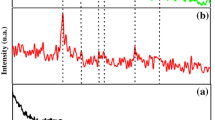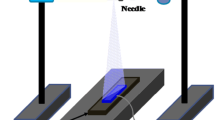Abstract
In this paper, we present a novel one-step, easy and cost-effective method for the synthesis of Ag-doped TiO2 sol and deposition of its compact thin films by spin coating technique. The effects of dopant quantity (0–5% by weight) on structural, morphological, optical and electrical properties of TiO2 thin films have been investigated and reported. The X-ray Diffraction (XRD) spectra revealed single anatase phase having no secondary phases. The scanning electron microscopy (SEM) showed pinholes-free/compact thin films composed of spherical nanoparticles where the particle size has been demonstrated to decrease with increasing Ag doping. The atomic force microscopy (AFM) confirmed smooth and compact TiO2 thin films, however, the surface roughness tends to grow with increasing the dopant quantity. The X-ray fluorescence spectroscopy (XRF) revealed the presence of Ag mass percentage in the relevant samples, which has been demonstrated to grow with increasing the amount of dopant. The UV–Vis spectroscopy concluded the bandgap reduction of pure anatase phase of TiO2 (3.38 eV) as the Ag doping reaches to its maximum value of 5% (3.18 eV). Spectroscopic Ellipsometry has been employed to determine the thickness of thin films which was found to be in the range of ~ 100 nm, while electrical properties have been measured through DC-Hall Effect technique. It was found that the conductivity of thin films improved from 5.74 × 10–2 to 2.72 × 10–1 Ω−1 cm−1 on glass while on FTO-coated glass substrates, a higher value of 1.51 × 104 Ω−1 cm−1 was achieved.






Similar content being viewed by others
Data availability
All the relevant data supporting this article have been included in the manuscript.
References
J. Cañas-Carrell et al., Metal oxide nanomaterials: health and environmental effects, Health and Environmental Safety of Nanomaterials (Elsevier, Amsterdam, 2014), pp. 200–221
S. Kumar et al., Metal oxides for energy applications, Colloidal Metal Oxide Nanoparticles (Elsevier, Amsterdam, 2020), pp. 471–504
J.I. Arishi, J. Ozuomba, Analysis of pure and Ag-doped TiO2 thin films deposited by field assisted spray pyrolysis. Chem. Sci. Int. J. 10, 1 (2018)
A. Fujishima, K. Honda, Electrochemical photolysis of water at a semiconductor electrode. Nature 238(5358), 37–38 (1972)
D.Y. Leung et al., Hydrogen production over titania-based photocatalysts. Chemsuschem 3(6), 681–694 (2010)
M. Rauf, M. Meetani, S. Hisaindee, An overview on the photocatalytic degradation of azo dyes in the presence of TiO2 doped with selective transition metals. Desalination 276(1–3), 13–27 (2011)
H. Park et al., Surface modification of TiO2 photocatalyst for environmental applications. J. Photochem. Photobiol. C 15, 1–20 (2013)
H. Liu et al., Self-cleaning Triboelectric nanogenerator based on TiO2 photocatalysis. Nano Energy (2020). https://doi.org/10.1016/j.nanoen.2020.104499
J.M. Rzaij, A.M. Abass, Review on: TiO2 thin film as a metal oxide gas sensor. J. Chem. Rev. 2(2), 114–121 (2020)
C. Tao, L. Zhang, Fabrication of multifunctional closed-surface SiO2-TiO2 antireflective thin films. Colloids Surf. A 585, 124045 (2020)
M.D. Pushpa et al., Influence of pyrolytic temperature on optoelectronic properties and the energy harvesting applications of high pressure TiO2 thin films. Vacuum 161, 81–91 (2019)
K.S. Anuratha et al., Electrodeposition of nanostructured TiO2 thin film as an efficient bifunctional layer for perovskite solar cells. Electrochim. Acta 295, 662–667 (2019)
X. Chen, S.S. Mao, Titanium dioxide nanomaterials: synthesis, properties, modifications, and applications. Chem. Rev. 107(7), 2891–2959 (2007)
D. Dambournet, I. Belharouak, K. Amine, Tailored preparation methods of TiO2 anatase, rutile, brookite: mechanism of formation and electrochemical properties. Chem. Mater. 22(3), 1173–1179 (2010)
T. Luttrell et al., Why is anatase a better photocatalyst than rutile? - Model studies on epitaxial TiO2 films. Sci. Rep. 4(1), 4043 (2014)
Z. Khan et al., Optimizing reaction kinetics of sequential deposition technique for ambient air and solution processed hybrid perovskite thin films. J. Mater. Sci. Mater. Electron. 30(4), 4250–4258 (2019)
O. Agirseven et al., Crystallization of TiO2 polymorphs from RF-sputtered, amorphous thin-film precursors. AIP Adv. 10(2), 025109 (2020)
A.G. Korpi et al., Influence of the oxygen partial pressure on the growth and optical properties of RF-sputtered anatase TiO2 thin films. Result Phys. 7, 3349–3352 (2017)
Y. Wu et al., Highly compact TiO2 layer for efficient hole-blocking in perovskite solar cells. Appl. Phys. Exp. 7(5), 052301 (2014)
W. Ke et al., Perovskite solar cell with an efficient TiO2 compact film. ACS Appl. Mater. Interfaces 6(18), 15959–15965 (2014)
J.H. Noh et al., Functional multilayered transparent conducting oxide thin films for photovoltaic devices. J. Phys. Chem. C 113(3), 1083–1087 (2009)
L. Kavan et al., Electrochemical characterization of TiO2 blocking layers for dye-sensitized solar cells. J. Phys. Chem. C 118(30), 16408–16418 (2014)
M. Khan et al., Structural, electrical and optical properties of multilayer TiO2 thin films deposited by sol–gel spin coating. Result Phys. 7, 1437–1439 (2017)
D. Dastan, Nanostructured anatase titania thin films prepared by sol-gel dip coating technique. J. Atom. Mol. Condens. Nano Phys. 2(2), 109–114 (2015)
B. Roose, S. Pathak, U. Steiner, Doping of TiO 2 for sensitized solar cells. Chem. Soc. Rev. 44(22), 8326–8349 (2015)
H.J. Snaith, L. Schmidt-Mende, Advances in liquid-electrolyte and solid-state dye-sensitized solar cells. Adv. Mater. 19(20), 3187–3200 (2007)
A. Hagfeldt et al., Dye-sensitized solar cells. Chem. Rev. 110(11), 6595–6663 (2010)
R.L. Hoye, K.P. Musselman, J.L. MacManus-Driscoll, Research update: Doping ZnO and TiO2 for solar cells. APL Mater. 1(6), 060701 (2013)
J. Song et al., Performance enhancement of perovskite solar cells by doping TiO2 blocking layer with group VB elements. J. Alloy. Compd. 694, 1232–1238 (2017)
G. Yin et al., Enhancing efficiency and stability of perovskite solar cells through Nb-doping of TiO2 at low temperature. ACS Appl. Mater. Interfaces 9(12), 10752–10758 (2017)
M.-C. Wu et al., Enhanced short-circuit current density of perovskite solar cells using Zn-doped TiO2 as electron transport layer. Sol. Energy Mater. Sol. Cells 157, 447–453 (2016)
H. Li et al., Spray deposited lanthanum doped TiO2 compact layers as electron selective contact for perovskite solar cells. Sol. Energy Mater. Sol. Cells 168, 85–90 (2017)
J. Jin et al., Enhanced performance and photostability of perovskite solar cells by introduction of fluorescent carbon dots. ACS Appl. Mater. Interfaces 9(16), 14518–14524 (2017)
J. Peng et al., Efficient indium-doped TiOx electron transport layers for high-performance perovskite solar cells and perovskite-silicon tandems. Adv. Energy Mater. 7(4), 1601768 (2017)
X. Zhang et al., Reduction of oxygen vacancy and enhanced efficiency of perovskite solar cell by doping fluorine into TiO2. J. Alloy. Compd. 681, 191–196 (2016)
S. Naghdi et al., A review of conductive metal nanomaterials as conductive, transparent, and flexible coatings, thin films, and conductive fillers: different deposition methods and applications. Coatings 8(8), 278 (2018)
D. Gogoi et al., Ag-doped TiO2 photocatalysts with effective charge transfer for highly efficient hydrogen production through water splitting. Int. J. Hydrog. Energy 45(4), 2729–2744 (2020)
Sheini, N.A. and Rohani, M.: Ag-doped titanium dioxide gas sensor. In: IOP Conference Series: Materials Science and Engineering. IOP Publishing (2016)
M. Nasr-Esfahani, M.H. Habibi, Silver doped TiO2 nanostructure composite photocatalyst film synthesized by sol-gel spin and dip coating technique on glass. J. Photoenergy Int. (2008). https://doi.org/10.1155/2008/628713
J. Luo et al., Effects of Ag-ion implantation on the performance of DSSCs with a tri-layer TiO 2 film. RSC Adv. 4(99), 56318–56322 (2014)
A.A. Mosquera et al., Effect of silver on the phase transition and wettability of titanium oxide films. Sci. Rep. 6, 32171 (2016)
S.W. Ryu et al., Effect of calcination on the structural and optical properties of M/TiO2 thin films by RF magnetron co-sputtering. Mater. Lett. 58(5), 582–587 (2004)
S. Tomás et al., Optical and morphological characterization of photocatalytic TiO2 thin films doped with silver. Thin Solid Films 518(4), 1337–1340 (2009)
A. Guillén-Santiago et al., Photocatalytic degradation of methylene blue using undoped and Ag-doped TiO2 thin films deposited by a sol–gel process: effect of the ageing time of the starting solution and the film thickness. Mater. Sci. Eng. B 174(1–3), 84–87 (2010)
L. Obalová et al., Photocatalytic decomposition of nitrous oxide using TiO2 and Ag–TiO2 nanocomposite thin films. Catal. Today 209, 170–175 (2013)
K. Ubonchonlakate, L. Sikong, F. Saito, Photocatalytic disinfection of P. aeruginosa bacterial Ag-doped TiO2 film. Procedia Eng. 2012(32), 656–662 (2012)
A.B. Nemashkalo et al., Electronic band structure studies of anatase TiO2 thin films modified with Ag, Au, or ZrO2 nanophases. Phys. Status Solidi B 253(9), 1754–1764 (2016)
E. Traversa et al., Photoelectrochemical properties of sol-gel processed Ag–TiO2 nanocomposite thin films. J. Sol-Gel. Sci. Technol. 22(1–2), 115–123 (2001)
C.-C. Chang et al., Photocatalytic properties of nanocrystalline TiO2 thin film with Ag additions. Thin Solid Films 494(1–2), 274–278 (2006)
M.K. Seery et al., Silver doped titanium dioxide nanomaterials for enhanced visible light photocatalysis. J. Photochem. Photobiol. A 189(2–3), 258–263 (2007)
Peerakiatkhajorn, P., et al.: Novel Photocatalytic Ag/TiO2 Thin Film on Polyvinyl Chloride for Gaseous BTEX Treatment. In: Materials Science Forum. Trans Tech Publ. (2012)
K. Ubolchonlakate, L. Sikong, T. Tontai, Formaldehyde degradation by photocatalytic Ag-doped TiO2 film of glass fiber roving. J. Nanosci. Nanotechnol. 10(11), 7522–7525 (2010)
A. Ranjitha et al., Enhanced photovoltaic performance of quantum dot sensitized solar cells with Ag-doped TiO2 nanocrystalline thin films. J. Mater. Sci. Mater. Electron. 25(6), 2724–2729 (2014)
F. Bensouici et al., Synthesis, characterization and photocatalytic behavior of Ag doped TiO2 thin film. Superlattices Microstruct. 85, 255–265 (2015)
S. Demirci et al., Synthesis and characterization of Ag doped TiO2 heterojunction films and their photocatalytic performances. Appl. Surf. Sci. 390, 591–601 (2016)
Halin, D.S.C., et al.: Synthesis and Characterization of Ag/TiO2 Thin Film via Sol-Gel Method. In: Solid State Phenomena. Trans Tech Publ. (2018)
K. Nanaji et al., Energy level matching for efficient charge transfer in Ag doped-Ag modified TiO2 for enhanced visible light photocatalytic activity. J. Alloy Compd. 794, 662–671 (2019)
M. Alijani, B.K. Kaleji, S. Rezaee, Improved visible light photocatalytic activity of TiO2 nano powders with metal ions doping for glazed ceramic tiles. Opt. Quant. Electron. 49(6), 225 (2017)
T. Ali et al., Enhanced photocatalytic and antibacterial activities of Ag-doped TiO2 nanoparticles under visible light. Mater. Chem. Phys. 212, 325–335 (2018)
H. Saleem, A. Habib, Study of band gap reduction of TiO2 thin films with variation in GO contents and use of TiO2/graphene composite in hybrid solar cell. J. Alloy Compd. 679, 177–183 (2016)
S.I. Mogal et al., Single-step synthesis of silver-doped titanium dioxide: influence of silver on structural, textural, and photocatalytic properties. Ind. Eng. Chem. Res. 53(14), 5749–5758 (2014)
A.A. Daniyan et al., Electrical properties of nano-TiO2 thin film using spin coating method. J. Miner. Mater. Charact. Eng. 2, 15–20 (2014)
T. Miyata, S. Tsukada, T. Minami, Preparation of anatase TiO2 thin films by vacuum arc plasma evaporation. Thin Solid Films 496(1), 136–140 (2006)
Acknowledgements
This research work was carried out at the School of Chemical and Materials Engineering (SCME), National University of Sciences and Technology (NUST), Sector H-12, Islamabad, Pakistan.
Funding
No external funding was involved in the present research.
Author information
Authors and Affiliations
Contributions
M. Arman Liaqat, Z. Hussain and Z. Khan contributed equally in the conception and design, acquisition and analysis of data as well as writing the manuscript. M. Aftab Akram and A. Shuja contributed in the acquisition and analysis of AFM and Hall Effect data. All authors have read and approved the final version of the manuscript.
Corresponding author
Ethics declarations
Conflict of interest
The authors declare that they have no conflict of interest.
Additional information
Publisher's Note
Springer Nature remains neutral with regard to jurisdictional claims in published maps and institutional affiliations.
Electronic supplementary material
Below is the link to the electronic supplementary material.
Rights and permissions
About this article
Cite this article
Liaqat, M.A., Hussain, Z., Khan, Z. et al. Effects of Ag doping on compact TiO2 thin films synthesized via one-step sol–gel route and deposited by spin coating technique. J Mater Sci: Mater Electron 31, 7172–7181 (2020). https://doi.org/10.1007/s10854-020-03288-9
Received:
Accepted:
Published:
Issue Date:
DOI: https://doi.org/10.1007/s10854-020-03288-9




